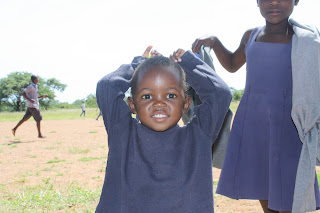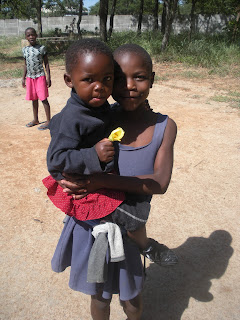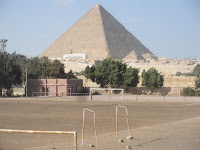Photo by Ale Frisch. Mine are the ugly ones at the bottom...
On Saturday morning we went back to Emthunzini Wethemba to play soccer with the kids. It was the first of what I hope will become a weekly ritual of spending time with the kids there playing soccer, helping to cook meals, gardening, helping to care for the chickens, or cleaning and organizing storage rooms. We arrived and I let Nkosi out of the car on a leash. I walked him towards some kids playing around the rickety swingset in the center of the yard. Emthunzini Wethemba’s campus buildings were built in the 1970s by the late Reverend Ndoda and his wife. The three main buildings form a courtyard, with the director’s quarters and the boys’ dormitory on the left, the girls’ dormitory and kitchen straight ahead, and the administrative offices and big girls’ dorm in the building to the right. The center of the courtyard is shaded by a few tall trees, and a giant tractor tire half-buried in earth alongside the swingset form a playground. On the other side of the swingset is a braai stand where the cooks were boiling water for morning sadza when I visited in December, because none of the stoves had been working.
The kids started screaming at the sight of Nkosi. As children on the streets of Bulawayo, I can’t even imagine what their experience with dogs has been. I did the stupidest thing possible, placing too much faith in Nkosi’s even temperament and love for kids. It was only 8am and I failed to take into account that he’s always wired in the morning. I made him sit and slipped his choke collar off. The kids shrieked and Nkosi cleared the playground in about 3 seconds. He chased a few girls all the way to the door of their dormitory, but I caught him before he could get inside. I put the leash back on him and threw him back in the car, where he remained for the rest of the visit. They’re not ready yet.
An elderly woman scolded me from the step of one of the buildings. I begged forgiveness for scaring the kids and she shook her head and told me to go see Sis P. Sistah P, the artist formerly known as Patience Dube, is the 25-year-old volunteer social worker and caretaker of 65 children. She was waiting for us in the administrative building. She greeted us as warmly as always but said we should probably go say good morning to the director. I prayed to God that the director wasn’t the lady who’d just yelled at me. She was.
The Reverend Ndoda’s wife still lives on the campus of Emthunzini Wethemba in the brick building forming the west side of the courtyard. Sistah P brought us into her brightly lit sitting room where several couches faced a wall dominated by a picture of the late Reverend. The director bustled in from the adjoining kitchen and we all stood to shake hands. I tried to be polite and apologized once more, but this elderly woman was stern: “You mustn’t come and just start playing with the children until you have made your presence known to Sis P.” I had anticipated a hiding for terrorizing twenty orphans with my dog, but instead, like all Zimbabweans, the director was simply a stickler for protocol. She made no mention of the kids’ canine conniptions. In the next breath her stern face dissolved in to a wrinkle-framed smile, and she grabbed me in an embrace and told me to call her “gogo” which means grandmother. Then she held me at arms length, jabbed a finger at my chest, and said forcefully, “I am your grandmother.” No arguing with that. “Yes ma’am!”
 We visited with Ma Ndoda for only a few minutes, but she shared a brief history of the orphanage and said she’d been living on the campus for more than twenty years. Then she ushered us out the door to greet the kids. “They’re waiting for you.” Sis P assembled all the kids, the ‘big girls’ once again bringing up the rear, and they all smiled expectantly. I brandished a soccer ball and they promised to show us where the football grounds were. But first, we had some business to attend to. My neighbors, the Brown family, collected more than 25 pairs of used youth soccer cleats and the boots made the journey with me from Boston, to NYC, to Cairo, to Joburg, and all the way to Bulawayo. I hauled the suitcase full of cleats out of the car and into Sis P’s office. Initially she called only six boys who were “the soccer players.” After they’d tried on boots and found pairs that fit, she started sending them running into the dining room where the rest the kids were eating breakfast. First they came one by one. Sis P would shout a name and a little kid would go running out the door in his new boots. He’d return hand-in-hand with another orphan and the new kid’s eyes would light up when he or she saw the suitcase full of cleats. Now boys and girls were getting involved and older kids helped younger ones try on different sizes. It was chaos, somehow organized by the maestro, Sis P. Meanwhile, the kids who’d already found their sizes had got a hold of the soccer ball we brought (the only ball they have is made from plastic bags) and were breaking in their new boots outside. Soon the suitcase was almost empty.
We visited with Ma Ndoda for only a few minutes, but she shared a brief history of the orphanage and said she’d been living on the campus for more than twenty years. Then she ushered us out the door to greet the kids. “They’re waiting for you.” Sis P assembled all the kids, the ‘big girls’ once again bringing up the rear, and they all smiled expectantly. I brandished a soccer ball and they promised to show us where the football grounds were. But first, we had some business to attend to. My neighbors, the Brown family, collected more than 25 pairs of used youth soccer cleats and the boots made the journey with me from Boston, to NYC, to Cairo, to Joburg, and all the way to Bulawayo. I hauled the suitcase full of cleats out of the car and into Sis P’s office. Initially she called only six boys who were “the soccer players.” After they’d tried on boots and found pairs that fit, she started sending them running into the dining room where the rest the kids were eating breakfast. First they came one by one. Sis P would shout a name and a little kid would go running out the door in his new boots. He’d return hand-in-hand with another orphan and the new kid’s eyes would light up when he or she saw the suitcase full of cleats. Now boys and girls were getting involved and older kids helped younger ones try on different sizes. It was chaos, somehow organized by the maestro, Sis P. Meanwhile, the kids who’d already found their sizes had got a hold of the soccer ball we brought (the only ball they have is made from plastic bags) and were breaking in their new boots outside. Soon the suitcase was almost empty.
The tiny pairs of cleats included in the collection made for some priceless fittings. One tiny boy named Gerard stood bewildered with a half-eaten piece of bread in his hand, staring at me and my camera while two teenage girls fitted him with a shiny pair of blue Diadoras, youth size 10.5. He beamed when he looked down at his feet and ran back to finish his breakfast, but he would be back.
Once all the kids had eaten and the empty suitcase was returned to the car, the kids wasted no time showing us the soccer grounds. We headed out the front gate and took a right towards the Mpilo Hospital OI clinic that stands next to the orphanage. The kids poured out of the gates, carrying the younger ones on their shoulders. Not a single kid stayed behind at the orphanage. We held hands and sang while we walked the half kilometer to the soccer pitch. Some of the teenage boys tore ahead, making me nervous as they darted into the road and screamed to each other while cars shot by, barely slowing. We reached the field, located behind the Mpilo Hospital Opportunistic Infections clinic. As the kids cavorted around the pitch I noticed faded gravestones poking between overgrown elephant grass beyond the far sideline. The kids were used to this sight by now, and were busy running laps, warming up. There was no question they were taking this very seriously. After 10 minutes of shooting around with the few kids who weren't running laps or completing spontaneously organized warm-up routines, we split into two giant teams and kicked the ball straight up in the air to start the game. Every single kid in the orphanage tore around the pitch, raising dust in the morning air and never slowing when the ball bounced into the half of the field where patchy grass had grown to knee height. We batted the ball back and forth across the field for 20 minutes, chasing it in clumps, before a goal was finally scored. It was worth the wait. A group of girls, purportedly on the scoring team but who had previously been engaged in a heated gossip circle at the other end of the field, immediately broke into a coordinated goal celebration that the rest of the team, and all the kiwhas, quickly took up. It was too good to not have been planned. Or it could just be that they’re African so they came out of the womb dancing.
That a soccer ball and a few foreigners could create such joy and diversion for so many orphaned kids, on a soccer pitch hauntingly situated between an AIDS clinic and a hospital graveyard, amazed me. On Saturday we began the daunting task of learning all 65 kids’ names, and we discovered that many are siblings. Without a doubt, some of their parents were treated (or were on the waiting list for treatment) at the very AIDS clinic they now live next door to. Six of them receive their own treatment for HIV there. The kids at Emthunzini Wethemba work hard in school and go to church every Sunday. Somehow, their fearless and admirable leader Sis P instills discipline and sound values into all of them. I’m just thankful to get a glimpse into this extraordinary community. Thank you to the Browns, my neighbors who made this morning of joy on the soccer pitch possible. I will continue to update about our adventures at EW with more pictures and stories.





































